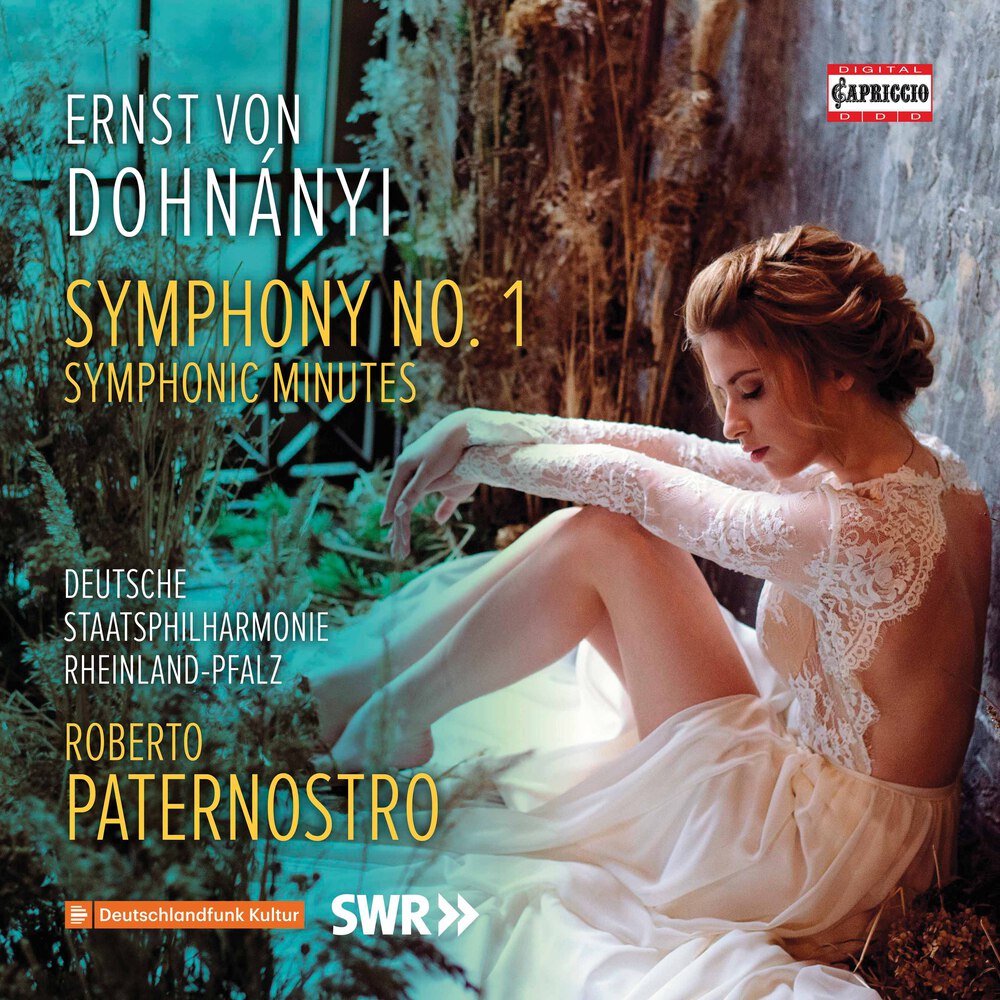
℗ 2019 CapriccioNR
| Released | October 4, 2019 |
| Duration | 1h 09m 34s |
| Record Label | CapriccioNR |
| Catalogue No. | C5386 |
| Genre | Classical (Orchestral) |
Dohnányi: Symphony No. 1 in D Minor, Op. 9 & Symphonic Minutes, Op. 36
Deutsche Staatsphilharmonie Rheinland-Pfalz, Roberto Paternostro
Available in 48 kHz / 24-bit AIFF, FLAC audio formats
|
Symphony No. 1 in D Minor, Op. 9
|
|||||
|
1.1
|
I. Allegro ma non troppo
Ernö Dohnányi; Deutsche Staatsphilharmonie Rheinland-Pfalz; Roberto Paternostro |
15:50 | |||
|
1.2
|
II. Molto adagio
Ernö Dohnányi; Deutsche Staatsphilharmonie Rheinland-Pfalz; Roberto Paternostro |
13:08 | |||
|
1.3
|
III. Scherzo. Presto
Ernö Dohnányi; Deutsche Staatsphilharmonie Rheinland-Pfalz; Roberto Paternostro |
6:03 | |||
|
1.4
|
IV. Intermezzo. Andante poco moto
Ernö Dohnányi; Deutsche Staatsphilharmonie Rheinland-Pfalz; Roberto Paternostro |
3:14 | |||
|
1.5
|
V. Finale. Molto sostenuto
Ernö Dohnányi; Deutsche Staatsphilharmonie Rheinland-Pfalz; Roberto Paternostro |
16:34 | |||
|
Symphonic Minutes, Op. 36
|
|||||
|
1.6
|
I. Capriccio. Vivacissimo possibile
Ernö Dohnányi; Deutsche Staatsphilharmonie Rheinland-Pfalz; Roberto Paternostro |
2:44 | |||
|
1.7
|
II. Rapsodia. Andante
Ernö Dohnányi; Deutsche Staatsphilharmonie Rheinland-Pfalz; Roberto Paternostro |
4:10 | |||
|
1.8
|
III. Scherzo. Allegro vivace
Ernö Dohnányi; Deutsche Staatsphilharmonie Rheinland-Pfalz; Roberto Paternostro |
1:46 | |||
|
1.9
|
IV. Tema con variazioni. Andante poco moto
Ernö Dohnányi; Deutsche Staatsphilharmonie Rheinland-Pfalz; Roberto Paternostro |
3:38 | |||
|
1.10
|
V. Rondo. Presto
Ernö Dohnányi; Deutsche Staatsphilharmonie Rheinland-Pfalz; Roberto Paternostro |
2:27 | |||
The Symphony No. 1 in D minor op. 9 belongs to Dohnányi’s early years of success. Among all the influences of the late Romantic tradition, that by Brahms’ music can be discerned here once more. From it, Dohnányi forms a kind of early Neo-Romanticism that can be viewed as a continuation of the 19th century while avoiding the Expressionist, sprawling violence of the beginnings of Modernism in the 20th century. Reminiscent of Mahler and Strauss is the sovereign treatment of the large orchestra, in which many details stand out, making a major contribution towards the quality of the work. The Symphonic Minutes op. 36 was written in 1933 in the context to compose a Hungarian dance game.
With this release Capriccio started a new Edition with recordings of these still less well-known but powerful music from the hungarian Composer Ernst von Dohnányi.
"I wasn’t prepared for this brilliant reading of Dohnányi’s First Symphony. I haven’t heard the Botstein recording, but comparison with the Bamert results in a toss-up: Paternostro is a bit broader in most movements, but the playing is equally incisive and Capriccio’s recording is wonderfully clear and full, with marginally more audible detail than Chandos gives Bamert. The only clear advantage for Bamert is his more energetic Scherzo, although even here Paternostro’s rhythms are a bit clearer. Solo woodwind work and the brasses altogether are truly distinguished. If you don’t yet have a recording of the Symphonic Minutes, Paternostro scores over Bamert in the choice of fillers; Bamert gives us the American Rhapsody, a less important work from Dohnányi’s last years."
- Fanfare
"The First Symphony in D minor was composed in 1901 and contains five movements. The first movement is in sonata form. Immediately, one is struck by a lush romantic sound, and interesting harmonies. One certainly can hear the influence of both Brahms and Bruckner here, but Dohnányi’s is very much an individual voice.
The symphony is followed by the five-short-movement Symphonic minutes, Op 36, written thirty odd years later. This work is cheerful, colourful, has a national flavour and colour, and ends the disc in style. The writing is dazzling and virtuosic, and it certainly makes me wish that the composer had written more."
- Classical Music Daily
48 kHz / 24-bit PCM – CapriccioNR Studio Masters
| Track title | Peak (dB FS) | RMS (dB FS) | LUFS (integrated) | DR | |
Album average Range of values | -3.74 -15.65 to -0.45 | -25.95 -36.21 to -21.85 | -21.83 -33.30 to -17.20 | 14 12 to 16 | |
| 1 | I. Allegro ma non troppo | -0.86 | -21.85 | -17.2 | 13 |
| 2 | II. Molto adagio | -1.40 | -28.19 | -23.6 | 16 |
| 3 | III. Scherzo. Presto | -1.11 | -22.24 | -17.3 | 13 |
| 4 | IV. Intermezzo. Andante poco moto | -15.65 | -36.21 | -33.3 | 12 |
| 5 | V. Finale. Molto sostenuto | -0.60 | -22.81 | -18.4 | 14 |
| 6 | I. Capriccio. Vivacissimo possibile | -6.41 | -28.02 | -24.8 | 13 |
| 7 | II. Rapsodia. Andante | -0.45 | -26.17 | -21.6 | 14 |
| 8 | III. Scherzo. Allegro vivace | -2.45 | -23.49 | -20.3 | 14 |
| 9 | IV. Tema con variazioni. Andante poco moto | -6.03 | -27.30 | -22.2 | 12 |
| 10 | V. Rondo. Presto | -2.47 | -23.20 | -19.6 | 14 |